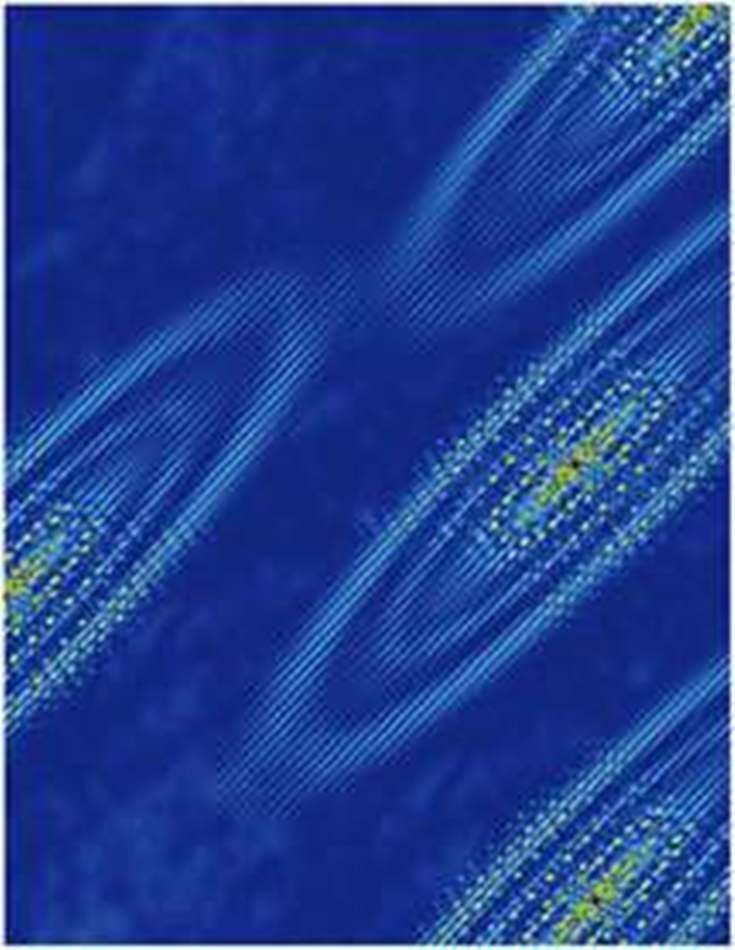Aug 20 2018
A new study, headed by Princeton University, demonstrated an evolving electronic behavior on the surface of bismuth crystals which could provide a better understanding of the progressing area of technology called “valleytronics.”
 Elliptical orbits of bismuth surface electrons in a large magnetic field. The orientation and interference patterns of the electronic states reveal that the electrons prefer to occupy a single valley. Image created using a theoretical model of the data. (Image credit: Ali Yazdani Laboratory, Princeton University)
Elliptical orbits of bismuth surface electrons in a large magnetic field. The orientation and interference patterns of the electronic states reveal that the electrons prefer to occupy a single valley. Image created using a theoretical model of the data. (Image credit: Ali Yazdani Laboratory, Princeton University)
The term valleytronics refers to energy valleys that occur in crystals and are capable of trapping single electrons. These energy valleys can potentially be used for storing information, thus considerably improving the possibilities of what can be achieved with contemporary electronic devices.
In the latest study, scientists discovered that electrons present in bismuth tend to crowd into a single valley and do not distribute uniformly into the six available valleys. Such a behavior generates a specific kind of electricity known as ferroelectricity, in which negative and positive charges are separated onto a material’s opposite sides. The study has been reported in the journal, Nature Physics.
This finding proves the latest prediction that when electrons congregate in a single valley, ferroelectricity arises naturally on the bismuth’s surface. These valleys are similar to pockets of low energy where electrons favor to rest, and are not literal pits in the crystal. By applying a technique known as scanning tunneling microscopy, in which an extremely fine needle is moved back and forth across the crystal’s surface, the team detected the electrons clustered in the valley. They achieved this feat at temperatures approaching close to absolute zero and under an extremely strong magnetic field, which was up to 300,000 times greater than the magnetic field of Earth.
Researchers can exploit the behavior of these electrons in future technologies. Highly ordered, repeating units of atoms are present in crystals, and it is through this order that accurate electronic behaviors emerge. The electronic behaviors of silicon have driven the latest developments in technology, but in order to widen humans’ capabilities, scientists are investigating novel materials. Valleytronics tries to exploit electrons so as to occupy specific energy pockets over others.
In bismuth, the presence of six valleys increases the potential of distributing data in six different states, where the absence or presence of an electron can be applied to indicate information. According to Mallika Randeria, the study’s first author and a graduate student at Princeton working in the laboratory of Ali Yazdani, the Class of 1909 Professor of Physics, the fact that electrons choose to collect in a single valley is an instance of “emergent behavior” in that the electrons behave together to enable innovative behaviors to emerge that wouldn’t take place otherwise.
“The idea that you can have behavior that emerges because of interactions between electrons is something that is very fundamental in physics,” said Randeria. Magnetism and superconductivity are other examples of interaction-driven emergent behavior.
Besides Randeria, the study also included equal contributions from Fengcheng Wu, a postdoctoral researcher at Argonne National Laboratory, and Benjamin Feldman, a former postdoctoral fellow at Princeton and now an assistant professor of physics at Stanford University.
Additional contributors at Princeton University were Hao Ding, a postdoctoral research associate in physics, and András Gyenis, a postdoctoral research associate in electrical engineering; Ji Huiwen, who earned a doctoral degree at Princeton and is now a postdoctoral researcher at the University of California-Berkeley; Robert Cava, Princeton’s Russell Wellman Moore Professor of Chemistry; and Yazdani. Additional contributions came from Allan MacDonald, professor of physics at the University of Texas-Austin.
The research was supported by the Gordon and Betty Moore Foundation as part of the EPiQS initiative (GBMF4530), the U.S. Department of Energy (DOE-BES grant DE-FG02-07ER46419), the U.S. Army Research Office MURI program (W911NF-12-1-046), the National Science Foundation’s MRSEC program through the Princeton Center for Complex Materials (NSF-DMR-142054 and NSF-DMR-1608848), and the Eric and Wendy Schmidt Transformative Technology Fund at Princeton. Work at the University of Texas-Austin was supported by DOE grant (DE-FG03-02ER45958) and by the Welch Foundation (TBF1473).
The study “Ferroelectric quantum Hall phase revealed by visualizing Landau level wave function interference,” by Mallika T. Randeria, Benjamin E. Feldman, Fengcheng Wu, Hao Ding, András Gyenis, Huiwen Ji, R. J. Cava, Allan H. MacDonald, and Ali Yazdani, was published online May 14, 2018, and in print in August, 2018, in the journal Nature Physics.